Everly Brothers
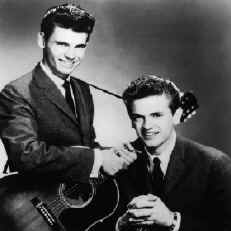
The Everly Brothers' teen hits brought into rock-'n' roll a
tradition of close-harmony singing which stretched back through
Appalachian country duos like the Louvin Brothers to centuries of
Scottish and Irish folk music. It was essentially from this that
their sharply observed - though sometimes maudlin -vignettes of
girl or parent trouble gained their emotional whack. The Everly
Brothers were one of the top acts in rock-and-roll history and,
perhaps, are more responsible than anyone for moving country
songs onto the pop charts.
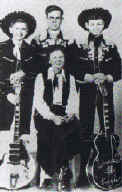
Everly family 1952
Photo courtesy Heide Ploen Collection
Ike Everly and to a lesser extent, his wife
Margaret, were well-known in the South and the Midwest as folk
and country music performers. Ike decided early in life to be a
musician. Ike with his brothers Charlie and Leonard would have
the most popular group in Muhlenberg county. Ike's guitar
playing was influenced by Merle Travis, Sam McGee and other
country music artists earlier in the Twentieth Century.
It seems that the brothers had composed an instrumental
combining bluegrass and ragtime called "That's The Mood I'm
In." Due to their lack of knowledge of the business
side of music, they never copyright it. Later it was
altered a bit and became a hit for Glenn Miller as "In The
Mood" under another writers name. The brothers played
everywhere and eventually ended up in Chicago for four years
before they broke up. From Chicago Everlys moved to Iowa for
seven years.
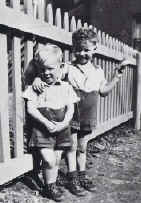
|
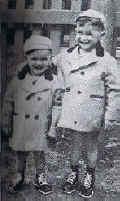
|
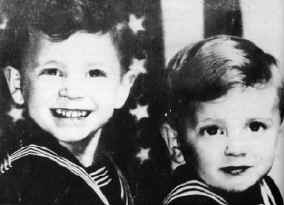
Don and Phil in 1941, ages four
and two
|
Isaac Donald Everly was born in Brownie, Kentucky in 1937 and
his brother Philip was born in Chicago two years later. The Don
and Phil were taught guitar at an early age and began singing
with their parents at ages eight and six respectively, a practice
that they continued through high school.
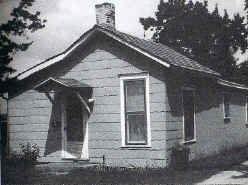
By 1945 they had moved to Shenandoah where Ike
was appearing three times a day on a local radio station.
Eventually, Margaret and the boys would join him over time. By
1950 The Everly Family Show was the most popular in the region.
Eventually they moved from Shenandoah to Evansville, Indiana. As
the demand for live radio performers declined they took to the
road once again traveling from town to town singing at county
fairs, political meetings and revivals.
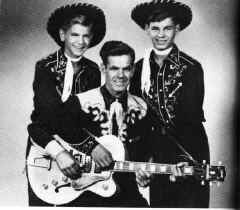
Photo courtesy Don Wayne Collection
Finally they settled in Knoxville where they appeared on radio
from 1953 to 1955. Ike knew Chet Atkins who was becoming a
success in Nashville as a session guitarist and recording star
for RCA Victor. When he was introduced to Phil and Don Atkins
liked what he saw and through his contacts Atkins got the
brothers a six month contract with Columbia Records.
They only had one recording session with Columbia in November,
1955. Four songs were recorded but, only "The Sun Keeps
Shining" b\w "Keep A' Lovin' Me" were released.
There was really nothing there to set it apart from other singers
from Appalachia. Only the vocals showed any promise. The
little airplay that the records received was from deejays that
knew the family.
Lack of success was nothing new to the Everlys. Don was asked
to be a songwriter with Hill and Range, a major Nashville
Publishing house. They continued to sing. Don switched to
Acuff-Rose publishing. Here he wrote "Thou Shalt Not
Steal" for Kitty Wells. His first royalty check was for $600
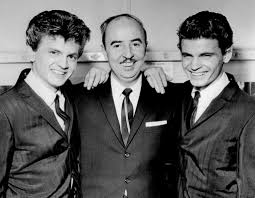
With Wesley Rose
|
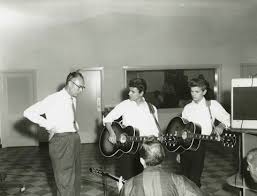
With Archie Bleyer
|
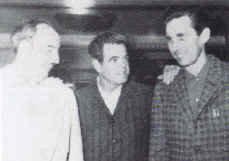
Wesley Rose, Ike Eveleyand Chet
Atkins 1957
Photo courtesy Jay Berman
collection
|
Wesley Rose was aware that Archie Bleyer was
looking for country talent and signed Phil and Don to Archie
Bleyer's Cadence label in 1957. Their first Cadence session was
in March, 1957 and overseen by old family friend Chet
Atkins.
The first song that they recorded "Bye Bye
Love" had been written by Felice and Boudleaux Bryant, a
middle-aged husband and wife songwriting team who had an unerring
ability to catch the angst and self-absorption of the average
teen.
"Bye Bye Love", had already been rejected by thirty
other acts. This time the boys and their musical mentor, Chet
Atkins had something new to add. The new Everlys sound kept the
high, keening harmonies, but backed them with robust acoustic
guitars and a rock 'n' roll beat that owed something to Bo
Diddley.
At the time country music was in a bit of decline as
rock-and-roll music, led by Elvis Presley, Chuck Berry, Little
Richard and others was becoming increasingly popular. The Everly
Brothers' recording of "Bye Bye Love" rejuvenated the
music business in Nashville, and it established Don and Phil
Everly as legendary performers.

Don Everly
|

Phil Everly
|
Cadence label and suddenly had their first big hit with
"Bye Bye Love," which reached number one on the country
charts and crossed over to reach number two on the pop charts.
For many acts the second release is more important then the
first.a million-seller. The first time they have the advantage of
being fresh and different. The second time can upset listeners by
being to close to the original or being to different.
Their next song "Wake Up Little Susie" came right in
between. The opening guitar was more thrilling and the vocals
more urgent. The song by the Bryant's was on the 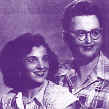 risqué side dealing with a
teenage couple that had fallen asleep at a drive-in movie and got
caught sneaking home.
risqué side dealing with a
teenage couple that had fallen asleep at a drive-in movie and got
caught sneaking home.
From 1957 to 1959, they had six top ten songs on the country
charts and seven top ten's on the pop charts. Many of these
recordings were written by the Bryants, whose country-flavored
compositions helped to add a new dimension to rock-and-roll.
Three songs that were written by Felice and Boudleaux Bryant and
recorded by the Everly Brothers reached number one on the pop
charts: "Wake Up Little Susie," "All I Have To Do
Is Dream," and "Bird Dog". "Cathy's
Clown" was their fourth and final number one pop hit in
1960.
The Everly Brothers left Cadence in 1960 over a royalty
dispute and signed with Warners for a million-dollar, ten-year
contract. Although this meant that they lost their production
team and the Bryants' songwriting, everything went well at first.
Don's "Cathy's Clown" was their biggest-selling single,
and Phil's "When Will I Be Loved", "Walk Right
Back", and "Ebony Eyes" all did well.
It was reported by 1961, that Don was addicted to Ritalin, at
that time considered to be a vitamin laced version of
methamphetamine. With his behavior becoming increasingly
erratic it was reported Don attempted suicide. In an attempt to
break the habit he underwent Electro-shock therapy.
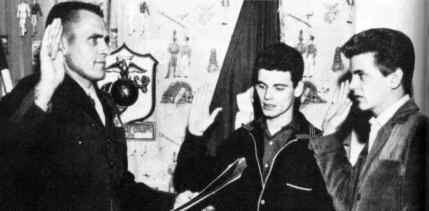
Enlisting in the Marines 1961
Photo courtesy Heidi Ploen Collection
With the likelihood of being drafted for two years in the
Army, on November 21, 1961, both Everlys joined the Marine Corp
Reserves for six months. While in the Corps during the first half
of 1962, they had a Top Ten hit with "Crying In the
Rain," but their military commitment restricted them from
capitalizing with club dates and tours.
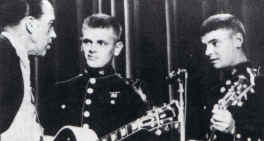
Ed Sullivan Show 1962
Photo courtesy Heidi Ploen Collection
On February 13, 1962, Don in his Marine dress uniform married
movie starlet, Venetia Stevenson, in the chapel at Camp
Pendleton, California. Five days later while still honeymooning
in New York City, the boys made an appearance on CBS-TV's The
Ed Sullivan Show in their dress uniforms. Don and Phil were
released from the Marines on May 24, 1962. Three weeks earlier
Warner Brothers issued "That's Old Fashion (That's the Way
Love Should Be)" which became their second Top Ten single in
a row. It was also their last.
Their career began to slow down in 1962 after a six-month
stint in the Marines. That November while in Britain rehearsing
for a tour Don collapsed on stage and Phil had to finish the tour
alone. By the time of the onslaught of the British Invasion in
1964 their career had pretty much run their course.
The Everly Brothers continued on in the
entertainment business. They had a summer television series on
CBS. However, Don and Phil were both having personal
problems. The unrelenting performance schedule led to an
addiction to speed for both. Don had a nervous breakdown.

Last show Knott's Berry Farm 4/14/1973
Photo courtesy Jay Berman Collection
Disagreements through the late 60s and early 70s; climaxed in
July 14,1973, midway through a concert in Knots Berry Farms
in Los Angeles. In the middle of the second of three scheduled
shows, the manager came on the stage and stopped the show.
He told the audience that he was upset with Don's sloppy
performance. Phil smashed his guitar, stormed off, and Don
announced that The Everly Brothers had split. According to Don,
the Everly Brothers "died ten years ago." Ten
years of solo career doldrums followed.

Royal Albert Hall reunion concert
Photo courtesy Jay Berman Collection
On September 23,1983, the Everly Brothers made
peace with each other and reunited as a singing duo at the Royal
Albert Hall in England. They recorded some albums together in the
80's that made it to the best seller charts. They retained their
popularity in England. In 1990, Don's daughter Erin was married
briefly to Axl Rose of the rock group Guns N' Roses.
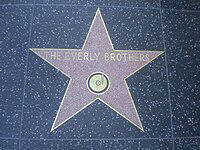
On October 2, 1986, The Everly Brothers received a star on the
Hollywood Walk of Fame for their work in the music industry,
located at 7000 Hollywood Blvd.
The Everly Brothers were inducted into the Rock
and Roll Hall of Fame 1986
The Everly Brothers were inducted into the Vocal
Group Hall of Fame in 2004













 risqué side dealing with a
teenage couple that had fallen asleep at a drive-in movie and got
caught sneaking home.
risqué side dealing with a
teenage couple that had fallen asleep at a drive-in movie and got
caught sneaking home.



